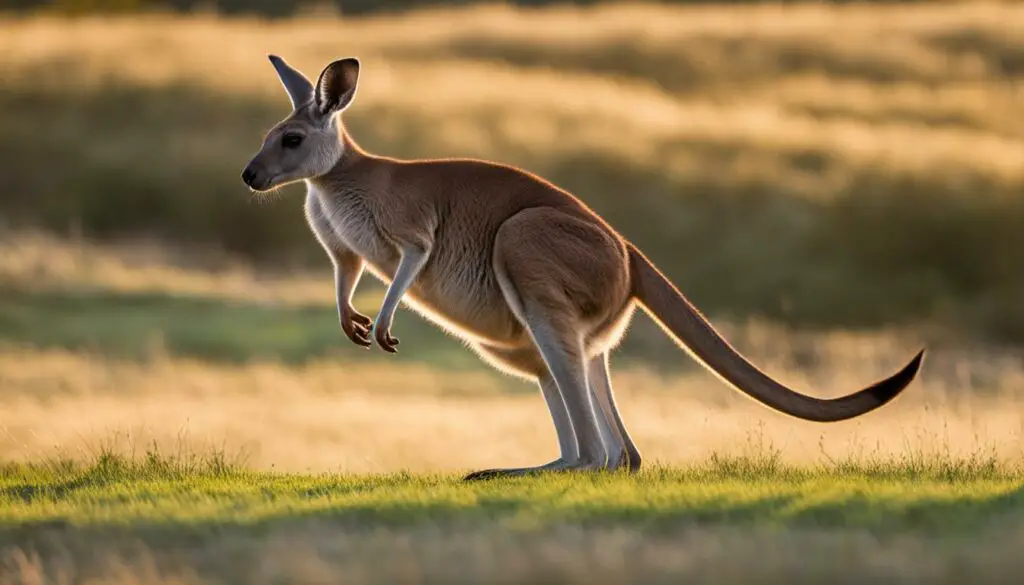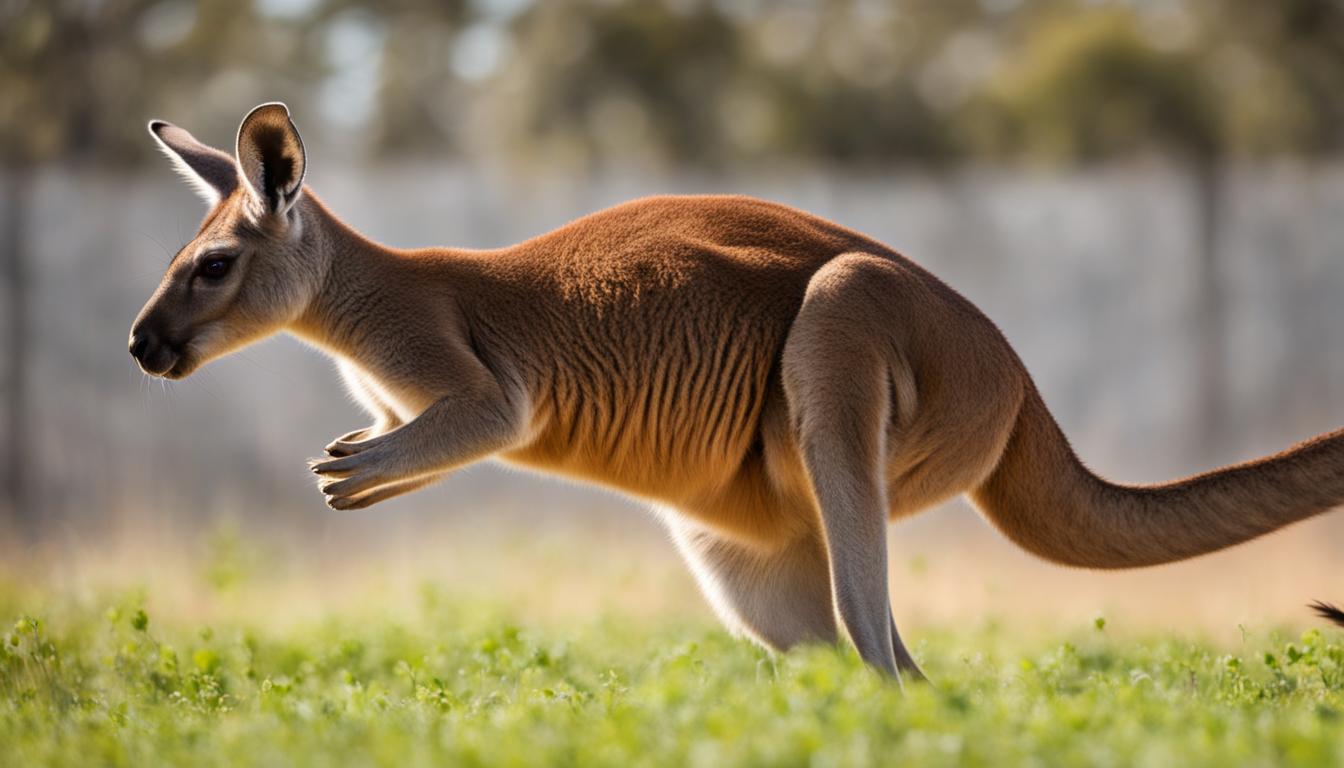If you’ve ever wondered about the speed and agility of kangaroos, you’re in for a treat. These unique creatures are the only large animals that use hopping as their primary means of locomotion. So, just how fast can they hop and what is their top speed?
When it comes to kangaroo hopping speed, the Red Kangaroo takes the lead. On average, they can comfortably hop at a speed of about 20-25 km/h (13-16 mph). But don’t be fooled by their leisurely pace. When needed, kangaroos can reach incredible speeds of up to 70 km/h (44 mph) over short distances. Imagine witnessing a kangaroo sprinting through the Australian outback!
But that’s not all – kangaroos can sustain a speed of 40 km/h (25 mph) for nearly two kilometers. Their powerful hind legs and large hind feet allow them to generate great force while hopping, while their thick, muscular tail acts as a tripod, providing balance and support. With these adaptations, kangaroos can jump 10 feet vertically, 40 feet horizontally, and even reach speeds of over 30 mph!
The speed and agility of kangaroos are truly remarkable. Their unique body structure and incredible adaptations have made them the largest hopping mammals and the largest marsupials. Stay tuned to learn more about the fascinating adaptations of kangaroos for hopping, their evolution and history, and the reasons why they choose to hop as their primary mode of transportation.
The Adaptations of Kangaroos for Hopping
Kangaroos have evolved unique adaptations that enable them to excel in their primary mode of locomotion – hopping. These adaptations, combined with their powerful hind legs and large hind feet, allow kangaroos to achieve impressive speeds and agility.
One key adaptation is their muscular tail, which acts as a tripod, providing balance and support while hopping. This thick, muscular tail allows kangaroos to maintain stability and control during their high-speed leaps. It acts as a counterbalance to their strong legs, enabling them to make quick and precise movements.
“The kangaroo’s tail is an amazing adaptation that assists in their hopping motion. It acts like a spring, storing and releasing energy with each hop, propelling the kangaroo forward,” says Dr. Sarah Johnson, a zoologist at the University of Melbourne.
During hopping, kangaroos tuck their hind legs forward and then push them back together in a powerful motion. Their tail and forefeet come forward to create a tripod, allowing them to bring their hind legs forward and continue hopping seamlessly. This synchronized movement, combined with their muscular tail, enables kangaroos to achieve their impressive hopping speed and bounding ability.
The Adaptations of Kangaroos for Hopping
| Adaptation | Description |
|---|---|
| Powerful Hind Legs | Kangaroos have strong hind legs, enabling them to generate significant force for each hop. |
| Muscular Tail | Their thick, muscular tail acts as a tripod, providing balance and support during hopping. |
| Large Hind Feet | Kangaroos have large hind feet, which help them push off the ground and propel themselves forward. |
The unique adaptations of kangaroos for hopping make them the largest hopping mammals and allow them to navigate their natural environment with speed and efficiency.
The Evolution and History of Kangaroos
Kangaroos are fascinating creatures that have a rich evolutionary history. These marsupials first appeared around 15 million years ago in Australia, and today, they are known for their incredible hopping abilities. With their unique body structure and adaptations, kangaroos have become the largest hopping mammals and the largest marsupials in the world.
There are over 100 species of kangaroos, ranging in size from small rabbit-sized creatures to those standing 7 feet tall and weighing up to 200 pounds. The evolution of these animals has led to their remarkable ability to hop and reach high speeds. This mode of locomotion allows kangaroos to cover large distances efficiently, a valuable trait in the arid and resource-scarce regions they inhabit.
The specific adaptations that enable kangaroos to hop at such impressive speeds include their powerful hind legs and large hind feet. These features allow kangaroos to generate significant force when jumping. Additionally, their muscular tail acts as a tripod, providing balance and support during hopping. By tucking their hind legs forward and then pushing them back together, kangaroos can propel themselves forward and maintain their momentum.

Overall, the evolution and history of kangaroos have shaped them into extraordinary creatures with unparalleled hopping abilities. Their remarkable speed and agility are a testament to their unique adaptations developed over millions of years. As we delve deeper into the world of kangaroos, we gain a greater appreciation for the diversity and wonder of the animal kingdom.
Why Do Kangaroos Hop?
Kangaroos hop as a means of locomotion for several reasons. One reason is that hopping is more energy-efficient compared to walking or running on four limbs, especially in a dry continent like Australia where resources can be scarce and located far apart. The hopping motion allows kangaroos to cover large distances more efficiently.
Kangaroos have evolved specific adaptations that make hopping a natural and effective mode of transportation for them. Their powerful hind legs and tail provide the necessary propulsion and balance, allowing them to achieve impressive speeds. The kangaroo’s hind legs are heavily muscled and designed for pushing off the ground, propelling their bodies forward with each hop. Their tail acts as a counterbalance, helping them maintain stability and control during rapid movements.
Additionally, the unique anatomy of kangaroos contributes to their ability to hop. The structure of their hind legs, with long, elastic tendons, allows them to store and release energy efficiently with each hop. This, along with their large hind feet, contributes to their ability to achieve high speeds and cover great distances. Overall, hopping has become an evolutionary advantage for kangaroos, enabling them to thrive in their natural habitat.
Interesting Fact:
“Kangaroos can cover up to 25 feet in a single hop.”
| Advantages of Kangaroo Hopping | Disadvantages of Kangaroo Hopping |
|---|---|
|
|
Conclusion
Kangaroos are truly extraordinary creatures, renowned for their amazing hopping abilities. With their powerful hind legs, large hind feet, and strong tail, they are capable of hopping at impressive speeds. The comfortable hopping speed for Red Kangaroo is about 20-25 km/h (13-16 mph), but they can reach speeds of up to 70 km/h (44 mph) over short distances.
Their unique adaptations and millions of years of evolution have made kangaroos the largest hopping mammals and the largest marsupials on Earth. These fascinating animals have developed special traits that enable them to cover vast distances efficiently through hopping, showcasing their remarkable speed and agility.
Whether it’s for foraging, escaping predators, or traversing their vast habitats, kangaroos have evolved to harness the power of hopping. Their energy-efficient hopping motion allows them to cover large distances more easily compared to walking or running on four limbs. This gives them a distinct advantage, especially in the challenging and often arid environment of their native Australia.
So, the next time you see a kangaroo bounding effortlessly across the landscape, marvel at their incredible speed and agility. These remarkable creatures are the epitome of grace and efficiency, showcasing just how incredible nature can be.
What is the Relationship Between a Kangaroo’s Hopping Speed and Their Mode of Locomotion?
The kangaroo hopping advantages play a crucial role in their mode of locomotion. These marsupials rely on their powerful hind legs to bound forward, reaching speeds up to 40 mph. The hopping motion enables kangaroos to cover large distances while conserving energy, as it requires less effort compared to running. This specialized form of locomotion is not only efficient but also allows them to navigate through diverse landscapes, making it a unique and advantageous characteristic of kangaroos.
FAQ
What is the comfortable hopping speed for a Red Kangaroo?
The comfortable hopping speed for a Red Kangaroo is about 20-25 km/h (13-16 mph).
How fast can kangaroos hop over short distances?
Kangaroos can reach speeds of up to 70 km/h (44 mph) over short distances.
How far can kangaroos sustain their hopping speed?
Kangaroos can sustain a speed of 40 km/h (25 mph) for nearly two kilometers.
How high can kangaroos jump vertically?
Some species of kangaroo, like the red and grey kangaroos, can jump 10 feet vertically.
How far can kangaroos jump horizontally?
Some species of kangaroo, like the red and grey kangaroos, can jump 40 feet horizontally.
How fast can kangaroos run?
Kangaroos can reach speeds of over 30 mph.
When did kangaroos evolve?
Kangaroos evolved around 15 million years ago in Australia.
What makes kangaroos the largest hopping mammals?
The unique body structure and adaptations of kangaroos make them the largest hopping mammals.
Why do kangaroos hop?
Kangaroos hop as a means of locomotion because it is more energy-efficient compared to walking or running on four limbs.











